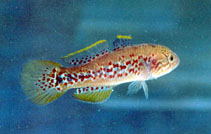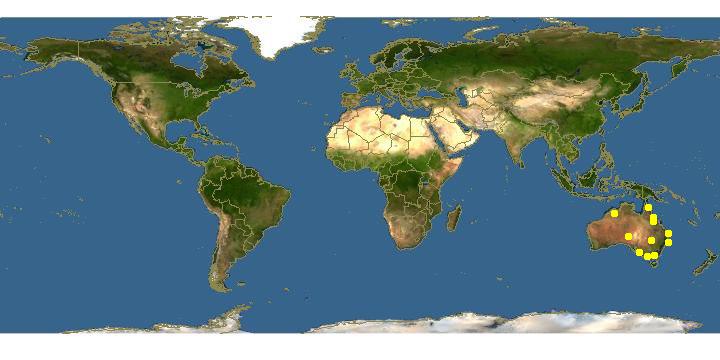http://www.fishbase.org/Summary/speciesSummary.php?genusname=Mogurnda&speciesname=adspersa ---> http://192.134.151.83/Summary/speciesSummary.php?genusname=Mogurnda&speciesname=adspersa
http://192.134.151.83/Summary/speciesSummary.php?genusname=Mogurnda&speciesname=adspersa ---> https://fishbase.mnhn.fr/Summary/speciesSummary.php?genusname=Mogurnda&speciesname=adspersa
https://fishbase.mnhn.fr/Summary/speciesSummary.php?genusname=Mogurnda&speciesname=adspersa ---> https://fishbase.mnhn.fr/summary/Mogurnda-adspersa.html
Mogurnda adspersa, Southern purplespotted gudgeon : aquarium

You can
sponsor
this page
Common name (e.g. trout)
Genus + Species (e.g. Gadus morhua)
-

-
About this page
-
Languages
-
User feedbacks
-
Citation
-
Uploads
-
Related species
-


 Southern purplespotted gudgeon
Upload your
photos
and
videos
Southern purplespotted gudgeon
Upload your
photos
and
videos
Pictures
|
Google image
 Mogurnda adspersa
Mogurnda adspersa
Male picture by
Aland, G.
Teleostei (teleosts) >
Gobiiformes
(Gobies) >
Eleotridae
(Bully sleepers)
Etymology:
Mogurnda:
Aboriginal name used in Australia
.
More on author:
Castelnau
.
Environment: milieu / climate zone / depth range / distribution range
Ecology
Freshwater; benthopelagic; pH range: 7.0 - ? ; dH range: 10 - 20. Subtropical; 16°C - 20°C (Ref.
2059
); 14°S - 36°S
Oceania: Murray-Darling system of Victoria, New South Wales and Queensland, Australia. Also eastern coastal drainages north of the Clarence River, New South Wales.
Length at first maturity / Size / Weight / Age
Maturity: L
m
?
, range 5 - ? cm
Max length : 14.0 cm TL male/unsexed; (Ref.
7276
); common length : 7.0 cm TL male/unsexed; (Ref.
7276
)
Inhabits slow-flowing or still waters, among weed (Ref.
7327
). Occurs in rivers, creeks and billabongs, usually over rocks or among vegetation (Ref.
44894
). Feeds on worms, dragonfly larvae, midge and mosquito larvae, crustaceans and mosquito fishes (Ref.
7327
). Maturity: F at 4.9 cm, M at 4.5 cm. Sexually dimorphic. Direct pair spawning in rivers and ponds at 19-34°C in Dec.-Feb. A single cluster of demersal eggs laid on a solid substrate, often close to vegetation (Ref.
7276
). Spawns during the rainy season (November to March). Females produce successive batches of 280-1300 eggs which are deposited on rocks, logs, or other solid debris. Males guard and fan the eggs until hatching, which takes about 3-9 days depending on temperature (Ref.
44894
). Preyed on by
Perca fluviatilis
and competes with mosquito fish (Ref.
7329
).
Male swims around female with all fins erect and opercula expanded. This courting behavior may continue for some days. Female deposits about 30 eggs and then rests while male fertilizes them. She then continues to lay another batch. After producing about 280-1300 eggs, the female moves away and the male remains to fan and guard the eggs until hatching (Ref.
7327
).
Allen, G.R.
, 1989. Freshwater fishes of Australia. T.F.H. Publications, Inc., Neptune City, New Jersey. (Ref.
5259
)
IUCN Red List Status (Ref.
130435
)
Least Concern (LC)
; Date assessed:
15 February 2019
CITES
Not Evaluated
Not Evaluated
Threat to humans
Harmless
Human uses
Fisheries: of no interest; aquarium: commercial
FAO - Publication:
search
|
FishSource
|
More information
Countries
FAO areas
Ecosystems
Occurrences
Introductions
Stocks
Ecology
Diet
Food items
Food consumption
Ration
Common names
Synonyms
Metabolism
Predators
Ecotoxicology
Reproduction
Maturity
Spawning
Spawning aggregation
Fecundity
Eggs
Egg development
Age/Size
Growth
Length-weight
Length-length
Length-frequencies
Morphometrics
Morphology
Larvae
Larval dynamics
Recruitment
Abundance
BRUVS
References
Aquaculture
Aquaculture profile
Strains
Genetics
Electrophoreses
Heritability
Diseases
Processing
Nutrients
Mass conversion
Collaborators
Pictures
Stamps, Coins Misc.
Sounds
Ciguatera
Speed
Swim. type
Gill area
Otoliths
Brains
Vision
Tools
Bio-Quiz
|
E-book
|
Field guide
|
Length-frequency wizard
|
Life-history tool
|
Point map
|
Classification Tree
|
Catch-MSY
|
Special reports
Check for Aquarium maintenance
|
Check for Species Fact Sheets
|
Check for Aquaculture Fact Sheets
Download XML
Summary page
|
Point data
|
Common names
|
Photos
Internet sources
AFORO (otoliths) |
Aquatic Commons
|
BHL
|
Cloffa
|
BOLDSystems
|
Websites from users
|
Check FishWatcher
|
CISTI
|
Catalog of Fishes
:
genus
,
species
|
DiscoverLife
|
ECOTOX
| FAO - Publication:
search
|
Faunafri
| Fishipedia |
Fishtrace
| GenBank:
genome
,
nucleotide
|
GloBI
|
Google Books
|
Google Scholar
|
Google
| IGFA World Record |
MitoFish
|
Otolith Atlas of Taiwan Fishes
|
PubMed
| Reef Life Survey | Socotra Atlas |
Tree of Life
| Wikipedia:
Go
,
Search
| World Records Freshwater Fishing |
Zoological Record
Estimates based on models
Phylogenetic diversity index (Ref.
82804
): PD
50
= 0.5000 [Uniqueness, from 0.5 = low to 2.0 = high].
Bayesian length-weight: a=0.00537 (0.00260 - 0.01111), b=3.09 (2.90 - 3.28), in cm total length, based on LWR estimates for this (Sub)family-body shape (Ref.
93245
).
Trophic level (Ref.
69278
): 3.5 ±0.48 se; based on food items.
Resilience (Ref.
120179
): High, minimum population doubling time less than 15 months (Preliminary K or Fecundity.).
Fishing Vulnerability (Ref.
59153
): Low vulnerability (10 of 100).
Back to Search
Random Species
Back to Top
Accessed through:
Not available
FishBase mirror site :
localhost
Page last modified by :
mrius-barile
- 20 July 2016
Fatal error
: Uncaught ArgumentCountError: Too few arguments to function checkEcotox(), 1 passed in /var/www/html/summary/speciessummary.php on line 2304 and exactly 3 expected in /var/www/html/includes/speciessummary.lib.php:2579 Stack trace: #0 /var/www/html/summary/speciessummary.php(2304): checkEcotox() #1 {main} thrown in
/var/www/html/includes/speciessummary.lib.php
on line
2579
|





